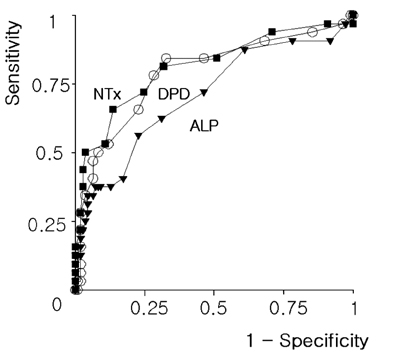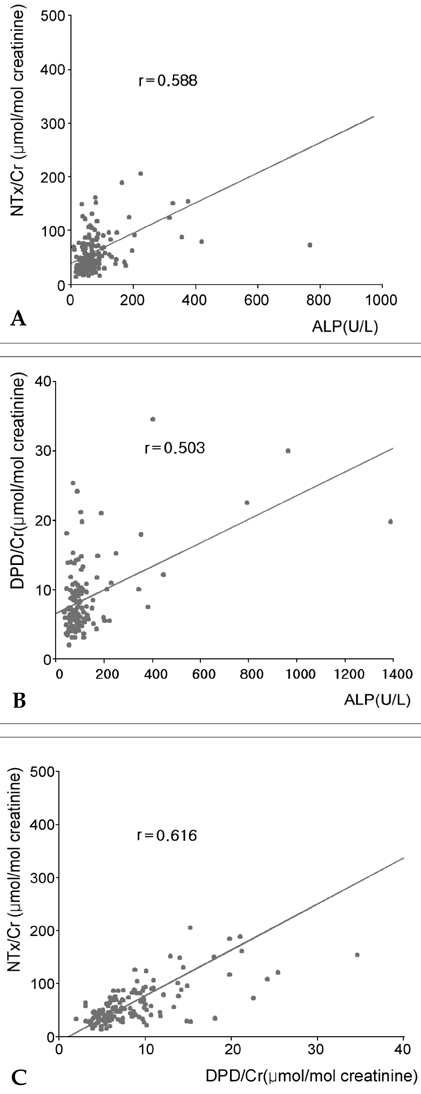Yonsei Med J.
2005 Jun;46(3):388-393. 10.3349/ymj.2005.46.3.388.
Usefulness of Bone Metabolic Markers in the Diagnosis of Bone Metastasis from Lung Cancer
- Affiliations
-
- 1Department of Internal Medicine, Kwandong University College of Medicine, Koyang, Korea.
- 2Department of Internal Medicine, Yonsei University College of Medicine, Seoul, Korea. sekyukim@yumc.yonei. ac.kr
- 3The Institute of Chest Diseases, Yonsei University College of Medicine, Seoul, Korea.
- 4Brain Korea 21 Project for Medical Science, Yonsei University College of Medicine, Seoul, Korea.
- 5Cancer Metastasis Research Center, Yonsei University College of Medicine, Seoul, Korea.
- KMID: 1734074
- DOI: http://doi.org/10.3349/ymj.2005.46.3.388
Abstract
- Bone metastasis is common in lung cancer patient and the diagnosis of bone metastasis is usually made by using imaging techniques, especially bone scintigraphy. However, the diagnostic yield from bone scintigraphy is limited. The aim of this study is to assess the clinical usefulness of urinary pyridinoline cross-linked N-telopeptides of Type I collagen (NTx), urinary deoxypyridinoline (DPD), and serum alkaline phosphatase (ALP) in the assessment of bone metastasis in patients with lung cancer. Urinary NTx, DPD, and serum ALP were measured in 151 lung cancer patients (33 with and 118 without bone metastasis). Lung cancer patients with bone metastasis had a higher urinary excretion of NTx and DPD, and a higher serum ALP than those without bone metastasis. NTx had a better receiver operating characteristic (ROC) curve than DPD and ALP, since the areas under the ROC curve were 0.82, 0.79, and 0.71, respectively. Although correlation coefficients among NTx, DPD and ALP were significantly positive (p < 0.005), the strongest relationship was appeared between NTx and DPD (R=0.616). In conclusion, our results showed the utility of the new bone markers in detecting bone metastasis and suggested that measurement of urinary NTx was valid diagnostic method of bone metastasis from lung cancer.
Keyword
MeSH Terms
Figure
Cited by 1 articles
-
The Role of Whole-Body FDG PET/CT, Tc 99m MDP Bone Scintigraphy, and Serum Alkaline Phosphatase in Detecting Bone Metastasis in Patients with Newly Diagnosed Lung Cancer
Joo-Won Min, Sang-Won Um, Jae-Jun Yim, Chul-Gyu Yoo, Sung Koo Han, Young-Soo Shim, Young Whan Kim
J Korean Med Sci. 2009;24(2):275-280. doi: 10.3346/jkms.2009.24.2.275.
Reference
-
1. Chute CG, Greenberg ER, Baron J, Korson R, Baker J, Yates J. Presenting conditions of 1539 population-based lung cancer patients by cell type and stage in New Hampshire and Vermont. Cancer. 1985. 56:2107–2111.2. Kim K, Kim KR, Sohn HY, Lee UY, Kim SK, Lee WY. The role of whole body bone scan in bronchogenic carcinoma. Yonsei Med J. 1984. 25:11–17.3. Perez DJ, Powles TJ, Milan J, Gazet JC, Ford HT, McCready VR, et al. Detection of breast carcinoma metastases in bone: relative merits of X-rays and skeletal scintigraphy. Lancet. 1983. 2:613–616.4. Lote K, Walloe A, Bjersand A. Bone metastasis. Prognosis, diagnosis and treatment. Acta Radiol Oncol. 1986. 25:227–232.5. Hanson DA, Weis MA, Bollen AM, Maslan SL, Singer FR, Eyre DR. A specific immunoassay for monitoring human bone resorption: quantitation of type I collagen cross-linked N-telopeptides in urine. J Bone Miner Res. 1992. 7:1251–1258.6. Ohishi T, Kushida K, Takahashi M, Kawana K, Yagi K, Kawakami K, et al. Urinary bone resorption markers in patients with metabolic bone disorders. Bone. 1994. 15:5–20.7. Tahtela R, Tholix E. Serum concentrations of type I collagen carboxyterminal telopeptide (ICTP) and type I procollagen carboxy-and aminoterminal propeptides (PICP, PINP) as markers of metastatic bone disease in breast cancer. Anticancer Res. 1996. 16:2289–2293.8. Sano M, Kushida K, Takahashi M, Ohishi T, Kawana K, Okada M, et al. Urinary pyridinoline and deoxypyridinoline in prostate carcinoma patients with bone metastasis. Br J Cancer. 1994. 70:701–703.9. Koga H, Naito S, Koto S, Sakamoto N, Nakashima M, Yamasaki T, et al. Use of bone turnover marker, pyridinoline cross-linked carboxyterminal telopeptide of type I collagen (ICTP), in the assessment and monitoring of bone metastasis in prostate cancer. Prostate. 1999. 39:1–7.10. Jakob C, Zavrski I, Heider U, Brux B, Eucker J, Langelotz C, et al. Bone resorption parameters [carboxy-terminal telopeptide of type-I collagen (ICTP), amino-terminal collagen type-I telopeptide (NTx), and deoxypyridinoline (Dpd)] in MGUS and multiple myeloma. Eur J Haematol. 2002. 69:37–42.11. Van Hoof VO, Van Oosterom AT, Lepoutre LG, De Broe ME. Alkaline phosphatase isoenzyme patterns in malignant disease. Clin Chem. 1992. 38:2546–2551.12. Seibel MJ, Duncan A, Robins SP. Urinary hydroxy-pyridinium crosslinks provide indices of cartilage and bone involvement in arthritic diseases. J Rheumatol. 1989. 16:964–970.13. Demers LM, Costa L, Chinchilli VM, Gaydos L, Curley E, Lipton A. Biochemical markers of bone turnover in patients with metastatic bone disease. Clin Chem. 1995. 41:1489–1494.14. Aruga A, Koizumi M, Hotta R, Takahashi S, Ogata E. Usefulness of bone metabolic markers in the diagnosis and follow-up of bone metastasis from lung cancer. Br J Cancer. 1997. 76:760–764.15. Kobayashi T, Gabazza EC, Taguchi O, Risteli J, Risteli L, Kobayashi H, et al. Type I collagen metabolites as tumor markers in patients with lung carcinoma. Cancer. 1999. 85:1951–1957.16. Alatas F, Alatas O, Metintas M, Colak O, Erginel S, Harmanci E. Usefulness of bone markers for detection of bone metastases in lung cancer patients. Clin Biochem. 2002. 35:293–296.
- Full Text Links
- Actions
-
Cited
- CITED
-
- Close
- Share
- Similar articles
-
- Quantitative Correlation between the Biochemical Markers and The Extent of Metastatic Bone Tumors
- The Usefulness of Measurement of Whole Body Count in Assessing Bone Marrow Metastasis in Cancer Patients with Increased Periarticular Bone Uptake on Follow-up Bone Scan: A Comparison with Bone Marrow Scan
- Impact of patient background factors on the treatment efficacy of once-weekly teriparatide
- A Report of Bone Marrow Metastasis of Colon Cancer as a Primary Diagnosis, Supported by Cytokeratin Immunohistochemical Staining
- Bone Scanning in the Evaluation of Lung Cancer




